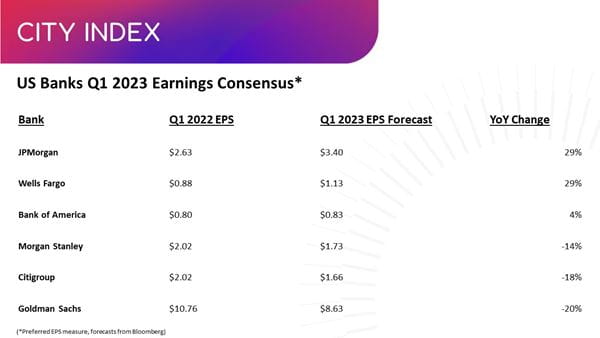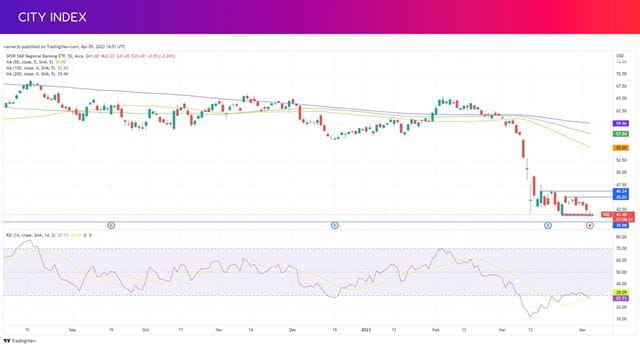
US banks earnings calendar
The US banks earnings season will see the industry report results for the first quarter of 2023. It will kick off on Friday April 14, when a group of the largest banks will report. That will be followed with more results out in the week of April 17, when the focus will start to turn toward smaller regional banks.
Below is a table outlining the dates for major US banks, as well as some of the smaller lenders that have been under the spotlight in recent weeks:
|
US Bank |
Earnings Date |
|
First Republic Bank* |
Apr-13 |
|
JPMorgan |
Apr-14 |
|
Citigroup |
Apr-14 |
|
Wells Fargo* |
Apr-14 |
|
PNC Financial |
Apr-14 |
|
Charles Schwab |
Apr-17 |
|
M&T Bank |
Apr-17 |
|
Goldman Sachs |
Apr-18 |
|
Bank of America* |
Apr-18 |
|
Bank of NY Mellon |
Apr-18 |
|
Morgan Stanley |
Apr-19 |
|
US Bancorp |
Apr-19 |
|
Fifth Third |
Apr-20 |
|
KeyBank |
Apr-20 |
|
Regions Financial |
Apr-21 |
(*To be confirmed)
US banks Q1 2023 earnings preview
This is a critical earnings season for US banks. They are tasked with restoring confidence after being shaken by the collapse of Silicon Valley Bank and Signature Bank in March, bringing back haunting memories of the 2008 financial crash that quickly spread over the Atlantic and led to embattled Credit Suisse being rescued by UBS.
Jamie Dimon, the boss of JPMorgan and the only CEO among the major banks to have survived the 2008 financial crash, warned just this week that the US banking crisis is ‘not over yet’ and warned that there will be ‘repercussions from it for years to come’. JPMorgan, as the largest US bank, led the efforts to rescue First Republic last month as a group of major lenders pumped $30 billion of deposits into the smaller regional lender after it suffered liquidity problems following a rush of withdrawals.
That uncertainty has made it difficult for banks to recover. Smaller lenders that are deemed to be more vulnerable have been the hardest hit with the SDPR S&P Regional Banking ETF down 32% since the start of March and currently at its lowest level since November 2020! Larger banks, deemed more financially secure, have proven more resilient but not immune to the situation. The Dow Jones US Bank Index – over 68% of which is weighted toward four of the largest banks – has lost 21% since the start of March.
Fears of contagion are easing for now, but traders and investors are still waking up in fear of hearing another domino has fallen, and the need to fix the cracks that have emerged in the banking system has still dramatically changed the outlook for bank stocks even if we are lucky not to see any more massive failures.
The risks of a recession have increased, partly because the crisis is expected to lead to tighter credit conditions that will make it more difficult for consumers and businesses to take out loans and other form of credit. Banks will be encouraged to be on the conservative side and ensure they have a better balance between loans and deposits. More limited availability of finance will mean clients will eat more into their deposits, which could exacerbate things, and force them to cut back on spending and investment.
That could happen at a time when the rush of withdrawals from banks into the likes of money market funds, where deposits have hit all-time highs due to the superior returns on offer, may force banks to make rates on their savings accounts more attractive, and therefore more costly, to ensure they are attracting capital rather than losing it. We have seen overall deposits in commercial US banks decline for nine consecutive weeks, according to the latest Fed data.
Meanwhile, the boost from higher interest rates is also set to hit its peak sooner than previously expected. The Fed is now hoping that tighter credit conditions will help bring inflation down and take the pressure off the central bank to keep raising rates. However, persistently high inflation and the difficulties posed by raising rates further could keep interest rates elevated for longer, although markets are currently pricing in multiple rate cuts before the end of the year!
The fragility of the industry is now also raising the threat that tighter regulations will be imposed in order to prevent something similar happening again, which would push up costs and could limit their ability to make money. For now, small and mid-sized banks are in the crosshairs considering they are not regulated or stress tested as much as larger banks despite collectively providing most of the loans that help fuel the US economy.
Bank stocks: What to watch out for in Q1 2023
Here are some of the areas that markets will be keeping an eye on…
Deposits and balance sheet strength
Regional banks faced a rush of withdrawals after the first bank failures since the last financial crash and markets are eager to know whether they are still seeing outflows of deposits or whether the situation is showing signs of stabilizing.
So, where did all those deposits go? There were reports that the largest banks saw an influx of deposits as clients moved their money into more financially-secure institutions, but it will be interesting to see just how much they attracted considering we have seen large sums flow into alternatives.
Ultimately, this earnings season will inform markets how strong, or fragile, the balance sheet of each individual bank is following the tumultuous events over the past month. Those that have stressed they can weather whatever storm is brewing have so far failed to convince the markets. Deposits, and the ability to cope with large-scale withdrawals, will be under the spotlight.
Loan loss provisions
Banks have already been building provisions that are set aside in case there is a rise in defaults on loans and the recent cracks in the system will only encourage them to build reserves at a faster pace now that talk of a recession has returned and because of tighter credit conditions and a more conservative attitude.
JPMorgan, Bank of America, Wells Fargo, Citigroup, Morgan Stanley and Goldman Sachs are forecast to collectively put $6.8 billion aside in the first quarter compared to just $2.8 billion the year before. Provisions are expected to continue climbing in 2023, which will weigh on profits.
Commercial real estate exposure
There has been much talk about the threat that the commercial real estate market poses to the banking sector. The outlook for many parts of the sector remains chellenging. Office demand is being tested amid the shift to hybrid and remote work. Demand for shop space is being confronted by businesses moving online, and even the boom for warehouses is waning. This, alongside the state of the wider economy, is testing property valuations.
With that in mind, there are fears that landlords and businesses will struggle to refinance their commercial property loans over the coming years. Interest rates are higher and will make the cost more expensive at a time when rental revenues are under pressure and banks are set to tighten their credit availability. The fact around 68% of all commercial property loans are held by the smaller regional banks rather than their larger peers only exacerbates the situation. Ultimately, it looks set to become more difficult and expensive. That raises the risk of default and of a meltdown in the sector causing havoc on the wider economy.
US banks earnings consensus
The majority of major US banks will start to come up against easier comparatives in 2023, although that won’t help all of them.
Consensus numbers from Bloomberg show that we will continue to see a varied performance from the industry, with JPMorgan and Wells Fargo set to see earnings jump while the likes of Morgan Stanley and Goldman Sachs are expected to see their bottom-lines come under pressure due to tough conditions for their investment management arms.

All these major banks are expected to deliver earnings growth over the full year in 2023 following the lower profits we saw in 2022, apart from Citigroup which is dealing with the costs of its transformation efforts that it hopes will deliver improvements over the longer-term. For now, the risks attached to the outlook and estimates for the remainder of the year are guided to the downside.
US Bank ETFs
You can trade individual bank stocks this earnings season, or you could opt to trade the sector as a whole given the uncertain environment.
For example, you could opt for the SPDR S&P Bank Index (KBE) if you want to trade the industry as a whole. This is comprised of around 66% regional banks with the rest made up of the larger banks and other financial firms.
If you want direct exposure to the more volatile regional banking sector, then go for the SPDR S&P Regional Banking ETF (KRE) that tracks the performance of a basket made up solely of small and mid-sized banks.
It is worth flagging the influence US bank earnings can have. The S&P 500 is weighted around 11% to financial stocks and their importance to the broader economy means their updates can impact the wider market.
Where next for the SPDR S&P Regional Banking ETF?
We can see that markets remain pessimistic about smaller players considering the SPDR Regional Banking ETF is still testing the 29-month lows we saw last month.
We are seeing support between the low of 41.28 and the opening price on March 24 at 41.55. Any drop below here would set a new 30-month low and see it fall toward, or possibly below, the 40.0 threshold.
The ETF remains in oversold territory as far as the RSI is concerned, supporting the view that the current floor can hold so long as there isn’t any more bad news from the sector. The initial upside target is 45.0 before 46.20 comes into the crosshairs. Recapturing this level would reinstall confidence it can start to regain the ground lost when the bulk of the selloff happened in the week to March 14.

Take advantage of extended hours trading
You can also take advantage of extended hours trading on a number of bank stocks, including JPMorgan, Bank of America and Wells Fargo.
US banks tend to release their results before the opening bell and most traders will have to wait until the markets open before being able to trade. But you can react immediately by taking a position in premarket hours.
While trading before and after hours creates opportunities for traders, it also creates risk, particularly due to the lower liquidity levels. Find out more about Extended Hours Trading.
How to trade bank stocks
You can trade bank stocks and ETFs with City Index in just four easy steps:
- Open a City Index account, or log-in if you’re already a customer.
- Search for the stock you want in our award-winning platform
- Choose your position and size, and your stop and limit levels
- Place the trade
Or you can practice trading risk-free by signing up for our Demo Trading Account.










